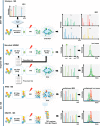Analysis of Major Histocompatibility Complex (MHC) Immunopeptidomes Using Mass Spectrometry
- PMID: 26628741
- PMCID: PMC4762616
- DOI: 10.1074/mcp.O115.052431
Analysis of Major Histocompatibility Complex (MHC) Immunopeptidomes Using Mass Spectrometry
Abstract
The myriad of peptides presented at the cell surface by class I and class II major histocompatibility complex (MHC) molecules are referred to as the immunopeptidome and are of great importance for basic and translational science. For basic science, the immunopeptidome is a critical component for understanding the immune system; for translational science, exact knowledge of the immunopeptidome can directly fuel and guide the development of next-generation vaccines and immunotherapies against autoimmunity, infectious diseases, and cancers. In this mini-review, we summarize established isolation techniques as well as emerging mass spectrometry-based platforms (i.e. SWATH-MS) to identify and quantify MHC-associated peptides. We also highlight selected biological applications and discuss important current technical limitations that need to be solved to accelerate the development of this field.
© 2015 by The American Society for Biochemistry and Molecular Biology, Inc.
Figures


Comment in
-
Origins of mass spectrometry-based proteomics.Nat Rev Mol Cell Biol. 2016 Nov;17(11):678. doi: 10.1038/nrm.2016.135. Epub 2016 Oct 5. Nat Rev Mol Cell Biol. 2016. PMID: 27703242 No abstract available.
References
-
- Berlin C., Kowalewski D. J., Schuster H., Mirza N., Walz S., Handel M., Schmid-Horch B., Salih H. R., Kanz L., Rammensee H. G., Stevanoviæ S., and Stickel J. S. (2014) Mapping the HLA ligandome landscape of acute myeloidleukemia: A targeted approach toward peptide-based immunotherapy. Leukemia 29, 647–659 - PubMed
-
- Kowalewski D. J., Schuster H., Backert L., Berlin C., Kahn S., Kanz L., Salih H. R., Rammensee H. G., Stevanovic S., and Stickel J. S. (2015) HLA ligandome analysis identifies the underlying specificities of spontaneous antileukemia immune responses in chronic lymphocytic leukemia (CLL). Proc. Natl. Acad. Sci. U.S.A. 112, E166–175 - PMC - PubMed
-
- Granados D. P., Sriranganadane D., Daouda T., Zieger A., Laumont C. M., Caron-Lizotte O., Boucher G., Hardy M. P., Gendron P., Côté C., Lemieux S., Thibault P., and Perreault C. (2014) Impact of genomic polymorphisms on the repertoire of human MHC class I-associated peptides. Nat. Commun. 5, 3600. - PMC - PubMed
Publication types
MeSH terms
Substances
Grants and funding
LinkOut - more resources
Full Text Sources
Other Literature Sources
Research Materials

